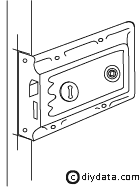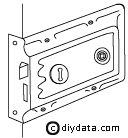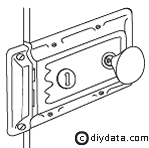Fitting a rim lock
Fitting a rim lock is quite straightforward but does need accurate measurements to ensure everything fits correctly.
A rim lock does not provide as much security as a mortise lock and they are usually fitted to relatively thin doors which won't accept a mortise lock.
 Start by deciding on the height of the rim lock; if in doubt, check the height of other locks in the property as ideally all the door handles should be the same height from the floor.
Start by deciding on the height of the rim lock; if in doubt, check the height of other locks in the property as ideally all the door handles should be the same height from the floor.
Position the rim lock body against the side of the door and mark around the endplate of the lock which sits against the door edge.
![]() Use a sharp chisel along the marked lines to establish the edges of the cut-out - this should stop any surface wood from lifting beyond the lines required.
Use a sharp chisel along the marked lines to establish the edges of the cut-out - this should stop any surface wood from lifting beyond the lines required.
Use a sharp chisel to remove the waste wood from the edge of the door to the depth of the endplate thickness so that the front of the endplate will be flush with the wood down the door edge.
Offer up the lock and locate the endplate into the cut-out - mark the position for the handle bar and the keyhole (if the door will never be locked from the reverse side, the keyhole may be omitted).
Drill the holes for the handle bar and keyhole - make the bar hole at least as big as the spindle boss on the back of the lock - for the keyhole, drill the top hole and cut out the shape using a thin pad saw.
 Position the rim lock on the door and secure using screws - heavy duty rim locks usually have two countersunk screws on the endplate (to go into the edge of the door) and four on the main body of the lock (which go into the side of the door). Modern light duty rim locks often only have the four screws on the main body.
Position the rim lock on the door and secure using screws - heavy duty rim locks usually have two countersunk screws on the endplate (to go into the edge of the door) and four on the main body of the lock (which go into the side of the door). Modern light duty rim locks often only have the four screws on the main body.
 Fit the door handles and key shield on the reverse side of the door.
Fit the door handles and key shield on the reverse side of the door.
The door handles have to be bar type with a small screw in the 'skirt' of each handle - the square bar having holes into which the screws locate. There may be a need to shorten the bar if its length stops both handles from sitting correctly.
 Close the door and mark on the door frame the position of the top and bottom of the rim lock.
Close the door and mark on the door frame the position of the top and bottom of the rim lock.
The 'staple' (which secures the lock catch and bolt when the door is closed) may have an endplate (like the lock) which will need to be recessed in to the door frame in a similar manner as for the lock endplate.
Position the staple on the door frame and mark around it. The architrave or moulding around the door will probably need to be cut away so that the staple will fit flat, in line with the lock and hold the door closed.
Once the cut-out has been completed, position the staple over the extended lock bolt and close the door, check that the top and bottom of the staple line up with the top and bottom of the lock before securing the staple to the door frame using screws - heavy duty locks often have two countersunk screws into the door jamb (like the lock) as well as two (or three) required to hold the staple to the side of the door frame.
